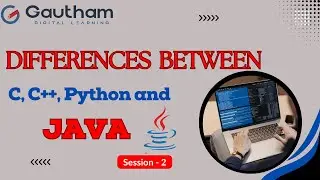Data Types in Python | Python Data Types | Python Tutorials | Python Videos | Python Course
For Python Live Classes, please contact us
Call us: +91- 9392105004, +91- 9391452336
Our Website: www.gauthamit.com
Please visit: https://learn.gauthamit.com
@gauthamdigitallearning
Welcome to our comprehensive guide on Python data types! In this video, we dive deep into understanding the fundamental data types in Python, providing you with essential knowledge to enhance your programming skills. Watch now to unlock the full potential of Python's data types and take your programming journey to new heights!
In Python, data types define the type of value that a variable can hold. Here are some of the built-in data types in Python:
Integers (int): Integers are whole numbers, without a fractional component. For example: 5, -3, 1000.
Floating-point numbers (float): Floating-point numbers represent real numbers and are written with a decimal point. For example: 3.14, 0.001, -2.71.
Strings (str): Strings are sequences of characters, enclosed in single (') or double (") quotes. For example: 'hello', "Python", '123'.
Boolean (bool): Booleans represent truth values, either True or False.
Lists: Lists are ordered collections of items. Items in a list can be of mixed data types. Lists are mutable, meaning their elements can be changed after the list is created. For example: [1, 2, 3], ['a', 'b', 'c'], [1, 'hello', 3.14].
Tuples: Tuples are ordered collections similar to lists, but they are immutable, meaning once they are created, their contents cannot be changed. Tuples are defined using parentheses. For example: (1, 2, 3), ('a', 'b', 'c').
Sets: Sets are unordered collections of unique items. Sets do not allow duplicate values. Sets are defined using curly braces {} or the set() constructor. For example: {1, 2, 3}, {'a', 'b', 'c'}.
Dictionaries (dict): Dictionaries are collections of key-value pairs. Each key is unique and is associated with a value. Dictionaries are defined using curly braces {}, with keys and values separated by a colon :. For example: {'name': 'John', 'age': 30}, {'key1': 100, 'key2': 200}.
Here's a brief example illustrating these data types:
python
Copy code
Integers
age = 25
Floating-point numbers
pi = 3.14
Strings
name = 'Alice'
Boolean
is_adult = True
Lists
numbers = [1, 2, 3, 4]
Tuples
coordinates = (10, 20)
Sets
unique_numbers = {1, 2, 3, 4}
Dictionaries
person = {'name': 'Bob', 'age': 30}
Python also supports more advanced data types and structures like classes, objects, and custom data structures.
Ready to take your Python skills to the next level? Hit that like button and subscribe for more coding adventures!
📞 For Enquiries & Registration:
📱 Call: +91-9392105004 , +91-9014529858
🌐 Visit: www.gauthamit.com
📚 LMS Platform: learn.gauthamit.com
📌Facebook: / gauthamdigitallearningnew
📌 Instagram: / gauthamdigitallearning
📌WhatsApp community: https://www.whatsapp.com/channel/0029...



















